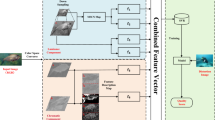Abstract
The object recognition under the sea is a difficult task due to the presence of different environmental conditions around oceans. Various techniques have been used to enhance the properties of underwater images. This paper proposed the pre-processing and feature extraction techniques for object recognition under the seawater. The proposed methodology consists of several pre-processing steps for underwater images to make a compatible image for feature extraction purposes, which helps in object recognition. The proposed pre-processing works on the intensity, contrast, and sharpness of the object to improve their visualization quality. We compared the proposed ALE algorithm (Atmospheric-Light-Enhancement Algorithm) with existing image enhancement techniques such as Intensity-based, Histogram based, Contrast-based image enhancement techniques. From the analysis, the ALE algorithm is most effective for underwater images. Also, a comparative analysis has been presented for feature extraction from underwater images using PCA (Principal Component Analysis), SIFT (Scale-Invariant Feature Transform), and SURF (Speeded up Robust Features) to extract the unique feature. The proposed technique SURF shows better results attainment in contrary to other feature extraction techniques. At last, in simulation analysis, we observed that the error rate and feature extraction time taken by SURF is better than PCA as well as SIFT, due to the speed up methodology of SURF during the feature points filtration.








Similar content being viewed by others
References
Ancuti CO, Ancuti C, De Vleeschouwer C, Bekaert P (2018) Color balance and fusion for underwater image enhancement,. IEEE Trans Image Process 27(1):379–393
Chen Y, Jiang H, Li C, Jia X, Ghamisi P (2016) Deep feature extraction and classification of hyperspectral images based on convolutional neural networks. IEEE Trans Geosci Remote Sens 54(10):6232–6251
Gao S-B et al (2019) Underwater image enhancement using adaptive retinal mechanisms. IEEE Trans Image Process 28(11):5580–5595
Iqbal N, Ali S, Khan I, Lee BM (2019) Adaptive edge preserving weighted mean filter for removing random-valued impulse noise. Symmetry 11(3):395–402
Li Y, Lu H, Li J, Li X, Li Y, Serikawa S (2016) Underwater image de-scattering and classification by deep neural network. Comput Electr Eng 54:68–77
Lu H, Uemura T, Wang D, Zhu J, Huang Z, Kim H (2020) Deep-sea organisms tracking using dehazing and deep learning. Mobile Netw Appl 25(3):1008–1015
Mayer P, Magno M, Benini L (2019) Self-sustaining acoustic sensor with programmable pattern recognition for underwater monitoring. IEEE Transactions on Instrumentation and Measurement 68(7):2346–2355
Panetta K, Gao C (2015) Human-visual-system-inspired underwater image quality measures. IEEE J Oceanic Eng 41(3):541–551
Salman A, Jalal A, Shafait F, Mian A, Shortis M, Seager J, Harvey E (2016) Fish species classification in unconstrained underwater environments based on deep learning. Limnol Oceanogr Meth 14(9):570–585
Srividhya K, Ramya MM (2017) Accurate object recognition in the underwater images using learning algorithms and texture features. Multimed Tools Appl 76(24):25679–25695
Verma K, Singh BK, Thoke AS (2015) An enhancement in adaptive median filter for edge preservation. Procedia Comput Sci 48:29–36
Villon S, Mouillot D, Chaumont M, Darling ES, Subsol G, Claverie T, Villéger S (2018) A deep learning method for accurate and fast identification of coral reef fishes in underwater images. Ecol Inf 48:238–244
Wang N, Sun J, Wang H, Zhou L, Chu C, Chen L (2019) ia-PNCC: Noise processing method for underwater target recognition convolutional neural network. Comput Mater Continua 58(1):169–181
Wong S-L, Paramesran R, Taguchi A (2018) Underwater image enhancement by adaptive gray world and differential gray-levels histogram equalization. Adv Electr Comput Eng 18(2):109–117
Xu L, Bennamoun M, An S, Sohel F, Boussaid F (2019) Deep learning for marine species recognition. Handbook of Deep Learning Applications. Springer, Cham, pp 129–145
Yang H, Lin H, Ding K (2018) Sliding window denoising K-Singular Value Decomposition and its application on rolling bearing impact fault diagnosis. J Sound Vib 421:205–219
Yang H, Li J, Shen S, Xu G (2019) A deep convolutional neural network inspired by auditory perception for underwater acoustic target recognition. Sensors 19(5):1104
Zhao M, Hu C, Wei F, Wang K, Wang C, Jiang Y (2019) Real-time underwater image recognition with FPGA embedded system for convolutional neural network. Sensors 19(2):350–362
Zhu M, Song Y, Guo J, Feng C, Li G, He B, Yan T (2017) Side-scan sonar image segmentation based on gray level co-occurrence matrices and unsupervised extreme learning machine. In OCEANS 2017-Aberdeen. IEEE, pp 1–4
Author information
Authors and Affiliations
Corresponding author
Ethics declarations
Conflict of interest
On behalf of all authors, the corresponding author states that there is no conflict of interest.
Additional information
Publisher’s note
Springer Nature remains neutral with regard to jurisdictional claims in published maps and institutional affiliations.
Rights and permissions
About this article
Cite this article
Kaur, M., Vijay, S. Underwater images quality improvement techniques for feature extraction based on comparative analysis for species classification. Multimed Tools Appl 81, 19445–19461 (2022). https://doi.org/10.1007/s11042-022-12535-6
Received:
Revised:
Accepted:
Published:
Issue Date:
DOI: https://doi.org/10.1007/s11042-022-12535-6




